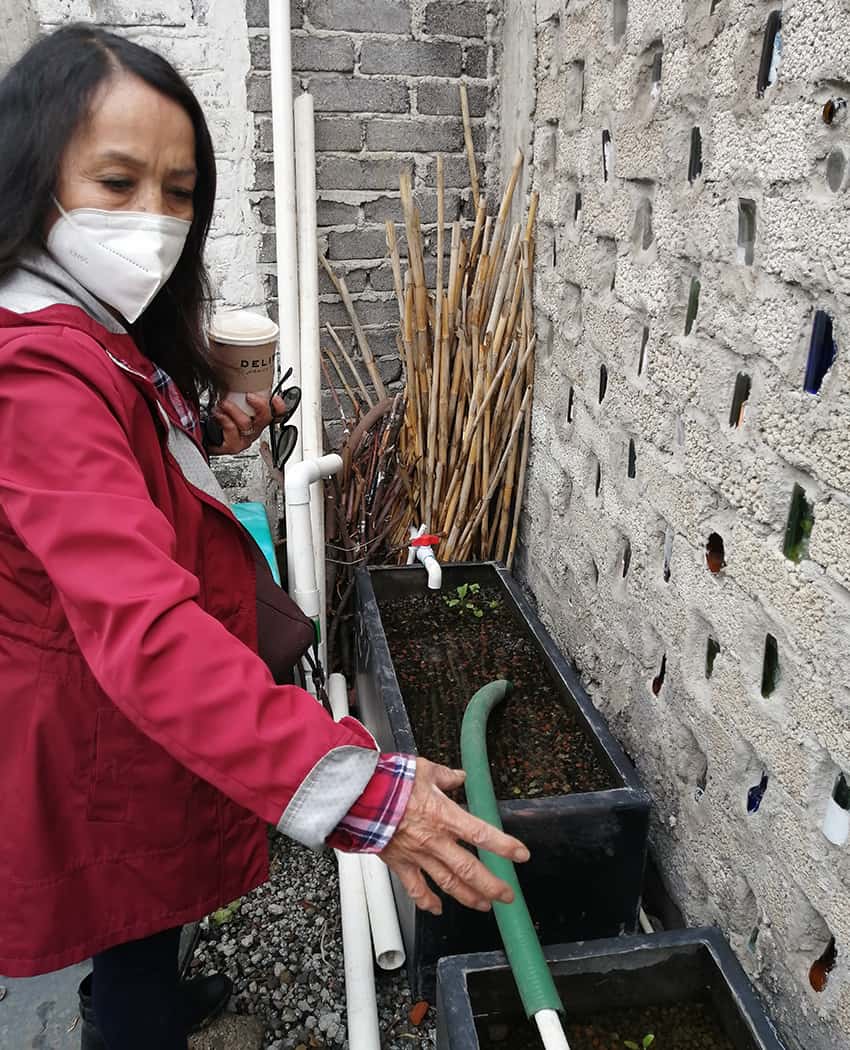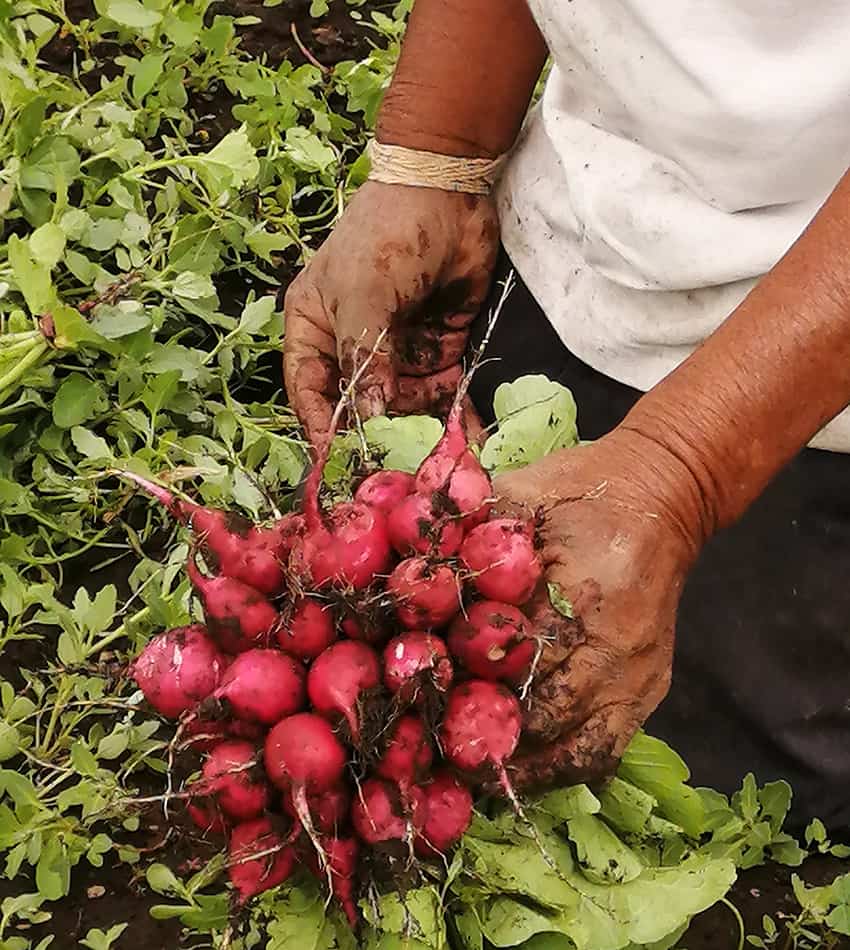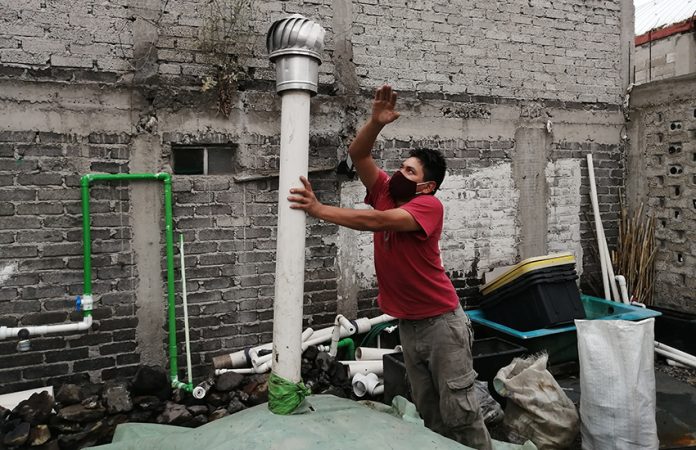It’s an overcast day in the heart of San Gregorio, one of 14 towns that make up the Xochimilco borough in southern Mexico City, and a small canal that ends in a cement landing is surrounded by piles of manure waiting to be used in the cultivation of the area’s vegetable farms.
San Gregorio is the area’s largest producer, cultivating tons of yearly vegetables that go on to be sold in the city’s massive central de abastos (produce market) and other local markets. The water in the canal is an electric green, choked by tiny algae called lenteja de agua (water lentils, also known as Lemna minor L.).
“It’s caused by an overwhelming amount of phosphorus and nitrogen in the water,” explains Refugio Rodríguez, a biotechnology scientist at Mexico’s National Polytechnic Institute. “It’s from the runoff when it rains that filters through fields laden with pesticides and untreated manure.”
Because of the plant cover, the water below doesn’t get sufficient oxygen, and little sun filters through it. This causes what little flora and fauna that exist to be stunted and creates a toxic environment for those that live near here.
Rodríguez is working to change this. After spending years working for monster polluters like Pemex and the Mexican National Railroad, Rodríguez’s life was changed five years ago on a single trip out to the canals in Xochimilco. It was a place that she, like many city residents, only thought of as a place for tourist boat cruises.

“I saw the problems that they had, how they were farming, and started thinking about the quality of food we were eating, and it affected me deeply. To see them water their crops with greywater, to see them unprotected like that, I just thought I could do something,” she says.
Rodríguez purchased a small plot of land two years ago and started to build the Center for Chinampa Education (CEDUCHI), a place that would offer workshops to farmers from the area and beyond, teaching methods to clean the immediate environment where they cultivate and improve the overall quality of the canals’ water and soil.
A simply built pump and filtration system sits enthroned in the center’s main workshop area. Made from high-impact PVC pipe and ultraviolet lamps, this machine can be built for around 40,000 pesos, or US $2,000, and will last about 20 years.
Its purpose is to gather both rainwater and canal water and send that collected water through a series of tubes where high-pressure nanobubbles and UV light rays destroy the water’s harmful microbes. The microbes have built up from years of runoff and illegal dumping in canals. In the case of rainwater, pollution has been drawn from the air as rain falls to the city’s surface.
In just 60 minutes, this pump can clean 240 liters of water, making it safe for washing, cooking and even drinking in certain circumstances.
Five pumps are already functioning in various places throughout the canals with several on individual chinampa island farms to help producers create clean sources of water for their crops and their families.
The pumps connect to simple rainwater catchment systems that can be mounted on the roofs of homes to capture some of the average 700 millimeters of water that fall during the city’s annual rainy season.
In the canals, the pumps work in conjunction with biofilters built right into them, which allow the water to first pass through various gravel layers and aquatic plants that reduce solids in the water and absorb some of the harmful microorganisms.
On the CEDUCHI patio, a mound of vegetable debris is being rotated by Refugio’s assistant to turn it into compost. Large PVC pipes stick out of the pile’s bottom to allow oxygen to enter and gases to release while it transforms.
This mound will be covered with plastic and left to sit for the next two months until it decomposes down to look like the finished product Rodríguez holds in her hand — a rich earthy compost, free of harmful microbes and rich in nutrients.
This compost model is already being used on Señor Pompilio Guerra’s farm a few miles away. One of the crops, radishes, is extremely sensitive to the high salinity in the area’s soil, and so they are incorporating Rodríguez’s compost into beds and using it to revitalize the soil and reduce salt levels.
Guerra has a large bunch of magenta radishes that he is picking under today’s cloudy sky. Just a month into production, they are already in shape to be sold.

The compost is made up of elements that are easily found in this watery landscape — lirio (a type of local water lily), orange rinds, dried leaves and grass and, in Rodríguez’s most recent version, used toilet paper.
The fungi produced on the skin of the oranges are sufficient enough to kill any harmful microorganisms in the mix, and they also help to reduce the area’s naturally high salinity.
Once the elements have time to decompose, the compost is safe enough to use on vegetables for human consumption.
Rodríguez has one more homespun invention up her sleeve. Similar to her stationery filtration pump, she has attached a nanobubble pump to several local trajineras (flat bottom boats used for pleasure cruises around the canals). The pumps run on solar power from panels strapped to the boats’ rooftops, and they push high-pressure nanobubbles deep into the canals’ water.
The size and force of the nanobubbles cause them to remain underwater and provide oxygen to areas that are in desperate need of it, as well as destroy harmful microbes and bust open the particles of greenhouse gases, eliminating them from the water’s chemical makeup.
This is what she is planning for the San Gregorio canal.
“[The nanobubbles] could reduce the growth of the lenteja de agua by getting rid of the pollution in the water. We have a plan,” she says.
CEDUCHI will allow Rodríguez that opportunity to share all the technologies she has painstakingly developed with all the farmers in the area, with the idea that these small models can be replicated and used throughout the country on similar problems. She hopes they will have a long-reaching effect on the larger conversation about water scarcity and water conservation in Mexico.
Lydia Carey is a regular contributor to Mexico News Daily.
